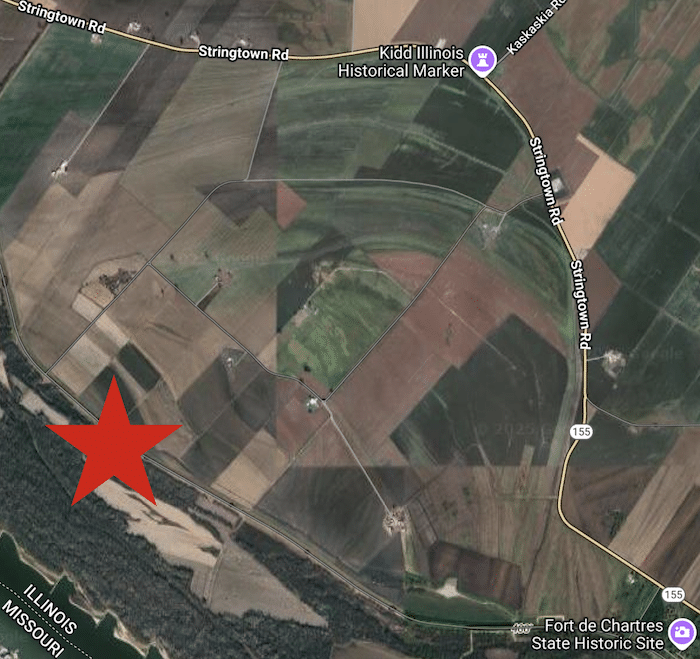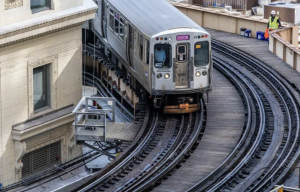Levee ‘devastation’ looms in Bottoms

A “scour hole” on the land side of the levee located just north of Prairie du Rocher is growing, and a bureaucratic “run around” may have already ensured the levee will fail, a key public safety official said.
Monroe County Emergency Management Agency Director Kevin Scheibe was joined by Lynden Prange of the Stringtown Drainage and Levee District during Monday’s meeting of the Monroe County Board to explain the worsening situation and urge the public to voice support for fixing the levee before it’s too late.
“We need help,” Scheibe said, explaining the scour hole – originally discovered in 2010 – had grown to an “alarming” size in recent years following high river levels encountered in 2015 and 2019.
“It’s not a matter of if (the levee fails), it’s when,” Scheibe told commissioners.
The scour hole is located near Levee Road south of Regtown Road – the two southernmost roads in Monroe County – less than one mile from the Randolph County line.
Due to the geography of the scour hole area, a levee failure would mostly send water north, though nearby Prairie du Rocher is also in danger, as Scheibe reported the nearby Fort de Chartres State Historic Site would “be at a (total) loss.“
Depending on the river level at the time of breach, up to 45,000 acres and 500 residences in Monroe County would be affected.
Scheibe told the Republic-Times on Tuesday that a river level of 35 feet would flood all of Fults, while a river level of 44 feet – which the area experienced in 2019 – would send water as far as the levee boundary in Fountain.
“There’s going to be devastation” when the levee breaks, regardless of river level, Scheibe told commissioners.
In 2022, The U.S. Army Corps of Engineers reported the scour hole had “progressed” and it had grown to more than 15 feet deep and was 185 feet from the levee by 2024 – a measurement which Scheibe said has become more severe more quickly in the past year.
Unlike sand boils, which are produced by underseepage caused by water pressure during times of high river levels, scour hole erosion is caused by flowing water – usually as it moves around obstacles in a river channel.
Scheibe explained that even though the Mississippi River levels have been below the 30-foot minimum flood stage since 2023, the water was still “undermining” and “cutting” into this scour hole.
“Even during drought-like conditions, maintenance equipment was driving through ‘wet areas’ on the residential side of the levee” east of the Mississippi River, Scheibe wrote in a grant request submitted in late January.
During a visit to the scour hole site on July 29, Scheibe observed that the hole was full of water and “even with the banks” while moving closer to the base, or toe, of the levee.
Water was approximately 25-30 feet from the top of the scour hole during the January visit.
Despite the apparent potential for a levee breach, Scheibe has been unable to secure repair funding from a number of agencies.
On Jan. 25, Scheibe was joined by State Rep. David Friess, Monroe County Board Chairman George Green, Prairie du Rocher Village President Mark Wilson and staffers for U.S. Rep. Mike Bost, State Sen. Terri Bryant, U.S. Sen. Tammy Duckworth, the Corps of Engineers, Illinois EMA and the Stringtown and Fort Chartres levee districts for an on-site visit to the scour hole to discuss possible mitigation measures.
Following the meeting, the Corps advised it is a “reactive” agency – meaning it is unable to provide financial assistance to prevent a levee failure – but would be able to step in once the failure occurs.
Scheibe said the cost of repair would be about $3 million, with estimated costs between $150 million and $300 million to deal with the aftermath of the levee failing.
“Once (levee failure) happens, they have an open checkbook,” Scheibe said, highlighting a frustrating policy restricting the Corps from funding disaster preventative and mitigation measures.
Monroe County Clerk Jonathan McLean noted county levee districts do not have a “good revenue source” to handle levee repairs, with the districts’ budget mostly funding power to water pumps and other non-structural maintenance.
Prange explained the Corps of Engineers were at one time responsible for all the levees until sometime in the 1980s when its funding was curtailed and the onus for levee integrity fell on the underfunded levee districts.
With the Corps not able to help, it was suggested to Scheibe to apply for IEMA grants, although the typical period to receive funds if selected is 18 months from the time of application.
“We don’t have 18 months,” Scheibe said on Monday.
Scheibe submitted a Building Resilient Infrastructure and Communities grant proposal to IEMA in late February requesting funding from the FEMA program.
In March, Scheibe was notified that all FEMA grants were on hold until further notice.
After re-submitting the proposal on May 21, Scheibe was notified July 17 that BRIC approval from IEMA had been pushed back to December, creating an eight-month delay before FEMA could even review the grant proposal.
The delay was caused in part by a FEMA announcement in April that it was “ending” the BRIC program in response to an executive order by President Donald Trump.
FEMA Director David Richardson later clarified he was not ending the BRIC program, but that he was “evaluating” it with the goal of giving individual states more control of disaster mitigation funds.
On Tuesday, a federal judge issued a preliminary injunction blocking the Trump Administration from reallocating nearly $4 billion in BRIC funds following a lawsuit filed last month by 20 states – including Illinois – which said the BRIC program is needed to fund disaster-prevention measure, such as repairing levees.
While it is unclear whether the Tuesday ruling could clear the way for federal funds to reach Monroe County, the timing of the grant process makes the move a moot point for the Stringtown Levee District.
Scheibe had also contacted Union Pacific Railroad representatives to ask for funds since one of its main Midwest cargo lines runs through Monroe County.
Union Pacific did not offer assistance, telling Schiebe if it helped Monroe County, it would have to help every levee program along the Mississippi River even though it costs tens of millions of dollars per day when trains are required to be re-routed around Monroe County.
“It sounds like everyone’s just waiting around for it to fail,” Monroe County Commissioner Doug Garmer said, referring to the lack of funding options despite the levee clearly approaching its breaking point.
With time running out and no immediately available funding options, Scheibe is asking Monroe County residents to contact elected officials.
Friess may be contacted online at Repfriess.com/contact or by calling 618-282-7284.
Bryant may be reached at 618-684-1100 or by visiting Senatorbryant.com/contact.
Bost may be reached at 618-457-5787, or visit Bost.house.gov/email.
The phone number for the Belleville office of Duckworth is 618-722-7070. Duckworth may also be contacted online at Duckworth.senate.gov/connect.
“Time is of the essence to eliminate the possibility of loss of life, property, historical venues and revenue,” Scheibe concluded in his January grant request.






